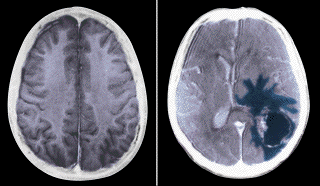Brain Tumor
Malignant brain tumors can affect both children and adult. Indeed,
they are quite common and comprise about 10 to 30% of all adult
cancers.

Healthy brain (left) compared to brain tumor
(shown in blue, right).
There are many types of brain tumors, which are classified according
to the affected tissue. They include:
- Glioma – glia or neuroglia, a tissue
that surrounds and supports the neurons or nerve cells of the
brain.
- Meningioma
– meninges or membrane enclosing the brain and spinal
cord
- Astrocytoma
– astrocyte or star-shaped neuroglia cell.
- Medulloblastoma
– cerebellum
- Ependymoma
– ependyma or epithelial membrane lining the ventricles
of the brain and the canal of the spinal cord
- Brain stem glioma – portion of the
brain that contains the medulla oblongata, pons Varolii, and
midbrain. This portion of the brain connects the spinal cord
to the brain.
Cause of Malignant Brain Tumor
About 20 to 40% of brain tumors originated elsewhere in the body.
These are cancer cells that metastasize or spread into the brain.
While the exact cause of other forms of brain tumors are unknown,
it is suspected that ionizing radiation can lead to malignant
growth. Ionizing radiation is a high-energy radiation that cause
damage to the DNA molecules, thus causing mutations that lead
to cancer.
Brain Tumor in Children
Brain tumor accounts for 20% of all childhood cancer, and affects
3 out of every 100,000 children. This incidence is the highest
before the age of 12 years, with about 1,200 new cases diagnosed
annually.
The most common forms of brain tumor in children are astrocytoma,
medulloblastoma, ependymoma, and brain stem glioma.
Symptoms and Signs
Tumor or growth in the brain cause destruction of the central
nervous system as it invades and destroy other brain tissues.
The physical mass of the tumor can also cause secondary effects,
such as:
The exact symptoms depend on the size, type and location of the
tumor, as well as the extent of the invasion. Onset of the symptoms
is often subtle, thus causing a high rate of misdiagnosis of brain
cancer.
Diagnosis
The following tests are used to diagnose brain tumors:
- Neurological assessment
- Skull x-ray and cerebral angiography
The blood vessels are examined by x-rays after injection of
a solution to make them visible.
- Computed tomography (CT) scan or magnetic resonance
imaging (MRI)
- Electroencephalogram (EEG)
This test measures the electrical activity of the brain. A tumor
may show up as localized abnormality.
- Spinal tap or lumbar puncture
In this test, a sample of the cerebrospinal fluid is taken from
the spine. Brain tumor would result in increased pressure, higher
protein level, decreased sugar or glucose level. There may also
be tumor cells in the cerebrospinal fluid.
- Tissue biopsy
A sample of the tumor is collected through a specialized surgery
using stereotaxis technique. Here, the surgeon can target a
specific location, guided by a CT scan or MRI.
Brain Tumor Treatment
Treatment of brain cancer depends on the type of the tumor, its
location and sensitivity to radiation and chemical agents. The
aims of the treatments are to remove the tumor if possible, or
if not then to reduce it, to relieve the symptoms and to prevent
further brain damage.
The following are some treatment options for brain tumor:
- Surgery
Resectable tumor (growth that can be removed surgically) are
treated by surgery called craniotomy where incisions are made
into the skull, followed by radiation therapy or chemotherapy.
Repeated surgery may be necessary.
- Chemotherapy
Chemotherapy uses chemical agents to kill rapidly growing cancer
cells. In case of brain tumors, to facilitate chemotherapeutic
drugs crossing the blood-brain barrier, additional drugs like
nitrosoureas (such as carmustine, lomustine, or procarbazine)
are used. These drugs are injected into the bloodstream and
into the space under the arachnoid membrane of the brain.
- Radiation therapy
Here, focused beams of high-energy radiation is used to selectively
kill the cancerous growth.
- Other medicines to control the symptoms
These include:
| Dexamethasone (synthetic steroid) |
To control cerebral edema or accumulation of fluid |
| Urea and mannitol (diuretic) |
To reduce brain swelling |
| Analgesics or pain killers |
To reduce pain |
| Antacids |
To reduce stress ulcers |
| Phenytoin (anticonvulsant) |
To reduce seizures |
Association:
References:


